yy
Hummingbird
Nest In The Backyard.
April 2003
April 2003
Hummingbird Record
2003 2004 2005 2006
_______________________
2003
Thursday, April 17, 2003
Photo of nest. Note size of 2 nestlings. Larger version
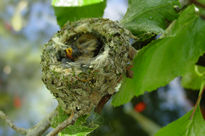
I was sitting outside by the koi pond, in my favorite after dinner chair, when I noticed a hummingbird going into the branches of our alder tree. To my surprise she sat on a small nest, her small nest01! I was careful to approach the nest only after the mother left to search for food. Didn't touch the nest in fear of the mother abandoning the young nestlings.
They initially thought I was the mother, so they begged for their dinner with their red beaks open. Then they went still. The next couple of days they were still when I approached the nest...I guess their mother gave them a stern lecture. To her I was probally just some very big bird that could possibly eat her chicks.
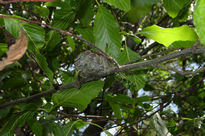
Thursday, April 17, 2003
Photo of nest. Very carefully attached to main and smaller branches with spider cobwebs. Larger version
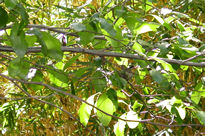
April 17, 2003
Photo of nest. To see well you'll need to click here for a Larger version
The nest was in a perfect location...far out on a slender branch. An animal would have a tough time getting out to the nest with their weight. It was about 6 feet up, directly over the pond, so nothing could come underneath and jump up at it. It was low in the tree so higher winds wouldn't disturb the nest much. The build of the nest was very impressive... just picturing this little hummingbird building this little work of art is just incredible. Around the rim she had woven in little pieces of green moss to blend it in with the surroundings. In fact you could only spot the nest from 2 areas. From the backside of the pond and from my favorite chair on the other side of the pond.
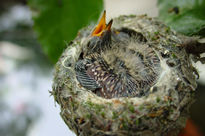
Wednesday, April 23, 2003
Photo of nest. Note size of nestlings. Larger version
Steve Garson
_______________________
California -- Migrating hummingbirds can arrive as early as January or February and departure dates are often in October. Anna's Hummingbirds are present year round. This is a large, diverse state. Contact your local Audubon Society for more information.
Anna's Hummingbird (Calypte anna)
Anna's is the most common hummingbird in southern California, and one of only two species that are permanent residents of the US or Canada (Allen's is the other). Unlike most other hummers, Anna's has a (minimal) song.
Physical Description
Average weight: male 4.31 g, female 4.07 g. The Anna's is the largest hummingbird seen on the west coast.
Plumage
Adult male:
Metallic green back, dark rose-red crown and gorget, grayish breast.
Adult female:
Green back, grayish-white breast, white throat with some red spots, white tips on outer tail feathers.
Juveniles:
Young of both sexes look like the adult female, but may have unmarked throats.
Distribution
Observed in Alabama, Alaska, Arizona, Arkansas, California, Colorado, Florida, Georgia, Idaho, Kansas, Louisiana, Mississippi, Missouri, Montana, Nevada, New Mexico, Oregon, Tennessee, Texas, Utah, Washington, and British Columbia (resident on Vancouver Island).
http://www.mbr-
pwrc.usgs.gov/id/framlst/
i4310id.html
For maps showing population distribution and trends, see the USGS species account.
_______________________
Muvees
Muvee1 Allen bathing
Muvee2 Female Ruby
Muvee3 Male Ruby
Muvee4 Hummingbird eats
Muvee5 Wingbeats - figure 8
Muvee6 Moth
PDF........Backyard Haven
_______________________
Links of Interest
Webcams of various nesting birds
• www.birds.cornell.edu/birdhouse/
nestboxcam/movies_home/
cam_links 111006

Anna's Hummingbird
14-18 days incubation
18-21 days until young first fly
32-39 days total
_______________________
2004
02/01?/04 - Sunday
Find unoccupied nest02 that is lopsided. Rains may have messed it up before hummingbird could lay eggs.
02/07/04 - Saturday
New nest03 spotted in bamboo. 2 eggs inside! Seems early in the season.
02/23/04 - Sunday
Weather: overcast/rainy. Watched mothers feeding cycle. How does she time it, a watch? By temperature?
On Nest ..11:28am
7 minutes sitting on nest, including 10 seconds feeding.
Left nest .11:35am
22 seconds off gathering food, then back on.
On Nest
11:57am
8 minutes sitting on nest.
Left nest
12:05pm
I was sitting by south end of pond. After leaving nest, she buzzed up to me. a couple feet right in front of me, paused then took off. Checking me out, warning me?
02/24/04 - Monday
Sorms, high winds, rain.
02/25/04 - Wednesday
Heavy rains knocks nest03 out of bamboo. : ( Find 1 dead nestling attracting ants, can't find the other one.
03/06/04 - Saturday
Find that hummingbird has rebuilt previous lopsided nest02. 1 egg found inside.
03/11/04 - Thursday
Find another egg inside!
03/24/04 - Wednesday
Eggs have hatched. 13 - 18 days later.
04/15/04 - Thursday
Nestlings fly away. 23 days later.
_______________________
2005
03/16/05
While refilling back yard hummingbird feeder, Dee Dee spots a new nest in bamboo and closer to waterfall. Mother was on nest so don't know if eggs or hatchlings?

04/22/05
Rains came and mother hummer abandoned nest. A week later she built another nest in bamboo about 8 feet to the left/north and much higher about. I figure hatchlings are about 14 days old.

04/30/05
Dee Dee and I went out to see hatchlings who are now fully grown at about 22 days from hatching. I had figured that they would be flying by this weekend. I got this closeup from up on the ladder with Dee Dee holding the base of the ladder. I'm probably about a foot away. I went up another rung in the ladder to get more level and the young hummers got spooked and buzzed out of the nest a couple a feet away into the bamboo. I felt a bit guilty but they seemed to have no problem flying. They wiil hang around for their mothers feeding. We'll watch to see if they go back to their nest or let mama feed them amongst the bamboo branches. Well at least I know how close I shouldn't be getting to them.
_______________________
2006
FIRST CLUTCH
01/22/06 - Sun. Sighting Day 1
01/16/06 - Est. Birth Day 6
Dee Dee refilled the hummingbird feeder, mostly because the sugar water was looking bad. We actually are having a mild winter, hardly has gotten close to freezing, so on occasion have been hearing hummingbirds around. Anyways, she looked around the bamboo, by chance, to look for nests and found one! The nest is in the north end of the bamboo at the end of a slender branch. She got the ladder and peered in and saw 2 small eggs! Later we both saw the mother buzzing to the nest.
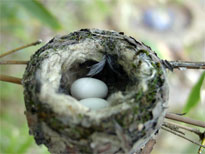
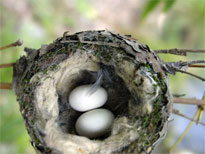
We have never have seen a nest so early in the season. Storms, rain, high winds and frost will come ... so chances are sadly slim for survival. From eggs to fly away is 20 days (approx. Friday Feb. 10), so we'll see if the weather gods are in her favor. Stay tuned.
02/04/06 - Sat. Sighting Day 14
01/16/06 - Est. Age Day 18 (incubation ave.: 14-18 days)
Dee Dee see hatchlings out of their eggs. Probably just hatched a day or two ago.
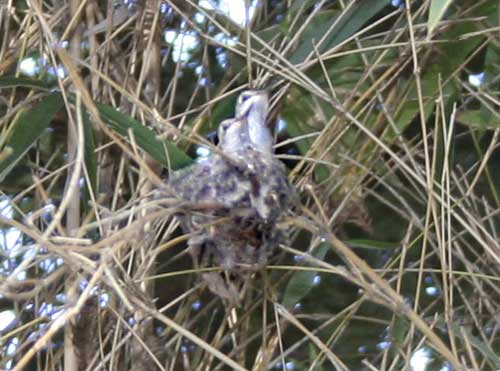
02/22/06 - Wed. Sighting Day 32
01/16/06 - Est. Age Day 36 (eggs laid to fly ave.: 32-39 days)
02/22/06 Went out to take photos. Nest barely visible in middle of the frames
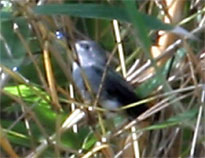
Cali (our mascot cat) was prowling around while we (my colleague Dan and I) were photographing the nest from the other side of the pond, and scared one out of the nest and it is hidden on bamboo branch to left of nest. Click on image above for full view.
The next day we noticed that the other hummer had flown away. We notice a hummer (mother or offspring?) buzzing around the upper branches of back yard trees.
It was so early in the season, we're sure there we be another clutch.
________________________
2ND CLUTCH
03/19/06 - Sun. Sighting Day 1
Dee Dee spots that hummingbird mom has rebuilt last years southern nest.
03/24/06 - Fri. Estimated Birthday
03/27/06 - Mon.
Age: Egg14/Live3/Total17
Dee Dee sees raw hatchlings. We've been having probably the wettest March in memory, but the not too much wind so hummers are hanging in there.
04/11/06 - Mon.
Age: Egg14/Live19/Total33
Been watching mother feed the hatchlings. Could be less than a week till fly away.
04/17/06 - Mon.
Age: Egg14/Live25/Total39
Fly away day! Right on schedule at maximum 39 days! Despite frequent rains, no fallen nestlings from winds. Hummers are standing up in their nest, restless, ready to go!
04/17/06 - Mon.
Age: Egg14/Live26/Total40
Morning, notice 1 hummer gone! The other is standing up in nest. Dee Dee and I get to witness probably a last feeding by the mother. Later that afternoon - gone! A successful 2nd clutch.
________________________
Anna's Hummingbird
14-18 days incubation
(from laying of eggs to hatching)
18-21 days until young first fly
32-39 days total
________________________
Steve Garson
Other interesting bird links:
_______________________
http://birds.audubon.org/
species/annhum
www.fws.gov
• hummingbird sound mp3
Is it best to stop feeding hummingbirds after Labor Day?
There is no evidence that feeding hummingbirds after Labor Day will keep them from migrating. In fact it may help a weakened straggler refuel for the long haul. Leave your nectar feeders out until the birds stop coming.
How long does it take for birds to find a feeder?
It may take more time for birds to find window feeders than hanging or pole-mounted feeders. You may want to wrap aluminum foil
around the top of the feeder hanger. Sometimes all it takes is the reflection of light on foil to catch their attention.
How can I avoid bees at my hummingbird feeder?
In hot weather especially, bees will tend to visit your feeder. Little plastic bee guards may help keep them from getting nectar but it won't stop them from trying. Putting vegetable oil around the feeding portals could contaminate the nectar. An alternative is to add a few small feeders away from where people are likely to be bothered by bees.
How close to my window can I put a feeder?
Birds will come right to your window. It takes patience because sometimes it will take them a while to overcome their initial reluctance. Birds might fly into the window because they see the reflection of the woods. Window feeders and decals help break up the reflection.
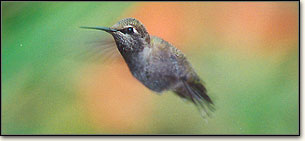
_______________________
http://www.hummingbirds.
net/
Welcome to hummingbirds.net, the source for information on attracting, watching, feeding, and studying North American hummingbirds
http://www.hummingbirds.
net/album.html
Great photos!!!!!
http://www.hummingbirds.
net/about.html
Great question/answers about hummers!!!
_______________________
The mission of the National Audubon Society is to conserve and restore natural ecosystems, focusing on birds, other wildlife and their habitats for the benefit of humanity and the earth's biological diversity. Founded in 1905, Audubon has over 550,000 members with 24 state offices, 508 chapters, and over 100 Audubon Sanctuaries and nature centers nationwide. (04/23/03)
http://www.goldengate
audubon.org/
2530 San Pablo Ave, Suite G Berkeley, CA 94702-2047 Phone: 510-843-2222
http://audubon-ca.org/
California Audubon
http://www.audubon.org/
National Audubon
_______________________

Rufous
http://images.fws.gov/
Free photos
FOLLOWING INFO FROM:
www.audubon.org
FAQ's (Frequently Asked Questions) about California birds
Daniel S. Cooper, Audubon California
PART I. ATTRACTING BIRDS
Q: How do I attract birds to my yard? A: Rather than feeding birds, try planting shrubs and trees that are native to your area. Check the phone book for nurseries that carry "native plants", or visit your local botanical garden during a plant sale.
FEEDING BIRDS
Q: Is it safe to feed my hummingbirds nectar with red dye?
A: Current thinking is that the red dye may not be good for them, nor is it necessary to attract hummingbirds. The color on your feeder is enough to attract them. You can mix your own nectar using 1/4 cup sugar to every 1 cup of water.
Q: Should I take my hummingbird feeder indoors during cold weather?
A: Unless you live in an area where the temperature is below freezing during most of the day, you probably don't need to do this. Since bird feeding has always been more prevalent in the eastern U.S., much of the traditional advice applies better to the East than the West. Three species of hummingbirds, Anna's, Costa's and Allen's, are year round residents across large parts of the state.
Q: What is safe to feed my backyard birds? A: Most of the pre-packaged wild birdseed and suet cakes are a favorite among backyard birds. This mixture can be obtained from most grocery stores, pet stores or Wild Bird Centers (1-800-WILD BIRD).
Q: How can I identify what kinds of birds are in my yard?
A: The best way is to purchase a bird identification book. The National Audubon Society has a Field Guide to North American Birds for the Western and Eastern regions. These books include color photographs and descriptions of the birds you may find in your backyard. One particularly good source for bird books is the Los Angeles Audubon Society Bookstore (323) 876-0202
PART II. INJURED OR SICK BIRDS
Q: What do I do if I find an injured bird?
A: First, make sure that it's injured! Many birds become exhausted during migration (spring and fall), and trying to help is not recommended. If a bird is obviously hurt (e.g. broken wing), the best solution is to make the animal as comfortable as possible and call your local humane society or wildlife care center for directions and/or pick up.
Bay Area Wildlife Rehabbers:
Marin Wildcare San Raphael http://www.wildcaremarin.org/
hosp/rehab.htm East Bay Lindsay Museum/Wildlife Hospital
http://www.wildlife-museum.org/
PART V. NESTS, NESTLINGS, AND NESTING
Q: What do I do if a bird has fallen out of its nest?
A: It is natural for nestlings to jump out of the nest just before they can fly, and for the parents to bring them food during this period. Is is also perfectly natural for the parents to remove very young birds that are not thriving. If the adults are in the area (and sound agitated), just back off and let them take care of the young bird. Secure pets indoors during this time. If there are cats and dogs around that you cannot secure, gently pick up the bird and place it in a box or basket. Try locating the nest and place it back in as best you can. If you cannot find the nest, leave the young bird in a box or basket and place out of reach of predators and let the parents continue to feed their young.
Q: How long is the incubation period for my backyard birds? How long until the young ones leave the nest?
A: The length of time varies from species to species. Here are a few common birds:
Anna's Hummingbird:
14-18 days incubation;
18-21 days until young first fly
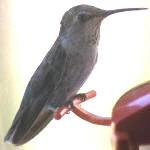
707 439-5323
me@
stevegarson.com
To Main Photo Page:
www.garsondesign/
photos
Updated: Sun 3/23/14 0:42 AM
Copyright © 2002 Garson Design Services
U